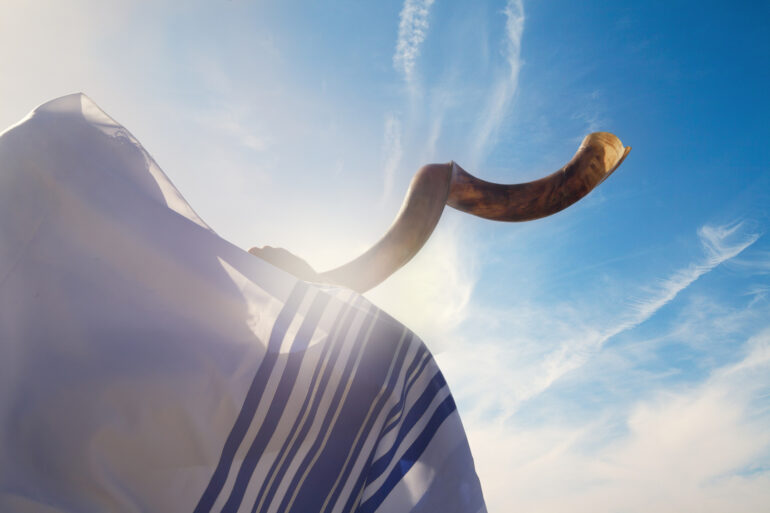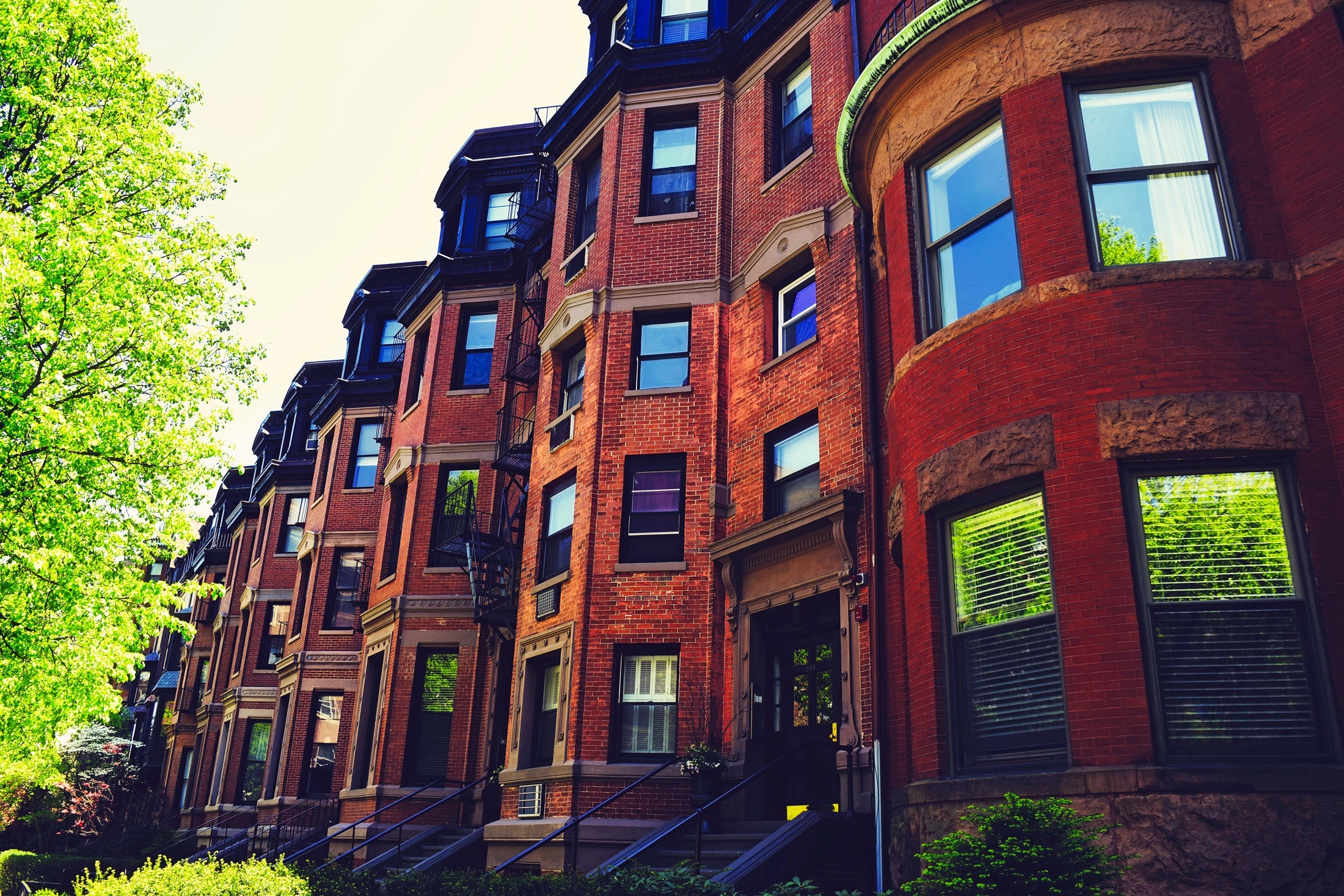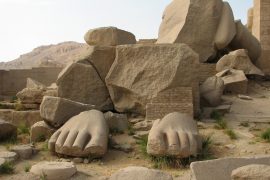Since the time of our liberation from Egypt, the Hebrew nation sounds the shofar on Rosh HaShana to inaugurate the new year. Rabbi Avraham Yitzḥak HaKohen Kook explains that the order of the shofar blasts – tekia, shevarim-terua, tekia – describes the inherent substance of all world events.
The Shofar Blasts of Rosh HaShana Parallel HaShem’s Stature from a Human Perspective
From the perspective of humankind, the blasts actually parallel HaShem’s stature in the world as perceived throughout the annals of history.
The initial shofar blast, the simple and constant tekia, symbolizes how the Kadosh Barukh Hu’s Divine Ideal was evident and manifest prior to the sin of Adam and during the initial periods when Israel enjoyed independence in our land. The intermediate irregular shevarim-terua blasts are broken sobs of weeping that represent the difficult historic intervals when Jews were exiled from our country and had to struggle for the political independence so vital to fulfilling our mission.
The tekia sounded after these broken blasts represent the children of Israel regaining self-determination in our land.
In the period of redemption, when Israel reestablishes the Divine kingdom on earth, the era of tekia will return and last forever as the final tekia during the Rosh HaShana service is greater than all blasts preceding it.
This great tekia refers to HaShem’s eternal sovereignty over Creation and man’s recognition of Him as the timeless ultimate Reality without end that creates all, sustains all, empowers all and loves all.
Israel’s Historic Mission to Bring Universal Recognition of HaShem
This universal recognition is achieved through the story of the Jewish people and the fulfillment of Israel’s historic mission. Through the establishment of a Hebrew kingdom in Eretz Yisrael that uplifts all branches of national life and reveals the Divine Ideal in all spheres of human existence, humanity will arrive at a state of higher consciousness. The liturgy therefore states that the Kadosh Barukh Hu “Reign over the entire world in Your glory” – elevate Israel among the nations so that the world will recognize HaShem’s absolute Oneness.
The shofar concept is intertwined with the historic process of the exiled Jewish people returning to our borders. In our daily tefillot, we say “sound the great shofar for our freedom, raise the banner to gather our exiles and gather us together from the four corners of the earth.” (Weekday Amida)
The Shulḥan Arukh code of Torah law teaches in Oraḥ Ḥaim, section 586 (also the numerical value of the word shofar) that there are three types of shofarot that can be used for Rosh HaShana. One should ideally use a ram’s horn but if this is impossible, he may draw on the horn of any kosher animal other than a cow. But if even this is unavailable, one is permitted to use the horn of an animal that is ritually unclean. Although it is acceptable in certain circumstances to sound this third shofar, one should not recite the accompanying brakha.
As the shofar is an integral theme in Israel’s liberation, each of these shofarot has a parallel in how the redemption can occur for both the Hebrew nation as a collective and for the individual Jews within. The great shofar (which we yearn for), the medium shofar and the small shofar each represent driving forces behind Israel’s return to Zion.
The way in which the great shofar calls us back to Eretz Yisrael is through the awakening of a desire to be redeemed and to redeem. It is the ancient Hebrew drive to actively participate in the Kadosh Barukh Hu’s plan for the redemption of humankind. This is revealed through a holy national awakening that grows from a deep connection to HaShem’s Divine Will and a thirst to restore Creation to what it was always meant to be – the goal towards which history has always been moving. Aliya motivated by the great shofar is the practical expression of Israel’s ancient spiritual yearnings.
The medium shofar has a different sound. It calls Jews back to our borders through feelings similar to the nationalisms found amongst gentiles. It beckons us through a nostalgia for our people’s story and the understanding that Eretz Yisrael is the land of our ancestors – where our forefathers lived, where we initially became a people, where our ancient history unfolded and where our civilization developed. It is the soil where Israeli kings reigned and where faithful prophets spoke. It is where our Temple majestically crowned the eternal city at a time when nearly the entire world stood in awe of Jerusalem’s grandeur. It is where we can live today as an independent nation with our own language and culture and where we can raise Hebrew children in a vibrant Israeli society. This is the sound of the medium shofar. While it certainly cannot compare to the great shofar, it is nonetheless also a positive sound.
Then there is the small shofar – the shofar over which one does not recite a brakha, although it must be sounded in the absence of the first two. This is the shofar that our antagonists blow. It is sounded as a warning for us to return to our own country while still possessing the opportunity to do so. It is a shofar that begins softly and grows louder as time escapes. It was this impure shofar that was sounded in Europe not long ago and it is this shofar that can again be heard today in countries throughout the world (in some places louder than others). Those who are deaf to the first two shofarot are eventually forced to listen to the third. Thus even the horn of an unclean beast plays a crucial role in the redemption of man.
We desire that HaShem “sound the great shofar for our freedom,” hoping that we not be subjected to the destructive sounds of the small shofar. Even the medium shofar is not entirely appropriate for the children of Israel’s unique role in human history. Rather, we ask for the great shofar – that of true freedom and complete redemption, bringing with it an all-encompassing kedusha that will revolutionize all of existence. A shofar must sound and we should strive for the ideal rather than merely making due with less perfect alternatives.
The redemption is unfolding in our generation. Those who are able to see it, recognize its universal benefit for humanity and desire to be a part of it merit to be awakened through the sound of the great shofar. Those that desire redemption but possess only a limited nationalist vision will be drawn to the natural healthy calls of the medium shofar. And finally those who are blind to the events transpiring in our days run the risk of being exposed to the blasts of the small shofar.
The sound of the great shofar must become so loud and obvious that no one should be able to ignore its reverberations.
This year, all Israel should be inscribed in the Book of Life for a meaningful year participating in the Kadosh Barukh Hu’s plan for universal redemption. We should all merit that our ears and our hearts be opened to the sound of the great shofar so that we may respond in unity as the reborn nation of Israel, blessing all of Creation with the light of HaShem’s Truth.





